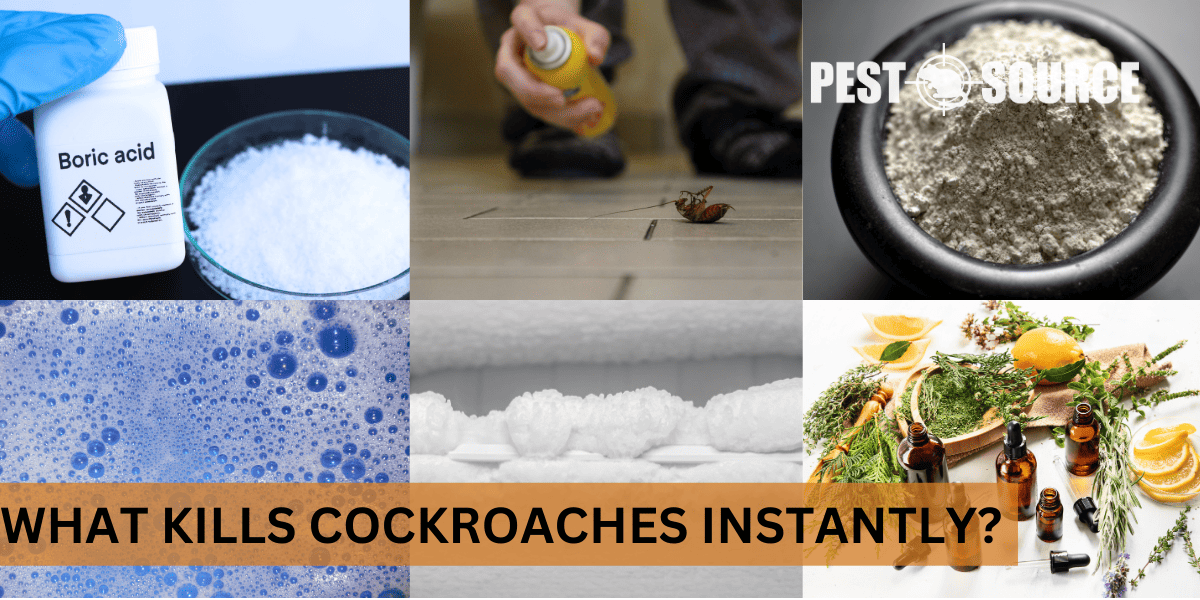Certain insecticides and home remedies can kill cockroaches instantly, with common options including boric acid, aerosol insecticides, and diatomaceous earth. This guide discusses these methods, how they work, and safety considerations for immediate cockroach extermination.
POINTS
- Chemical solutions, such as insecticides containing cypermethrin, can kill cockroaches instantly, but they require careful handling and are best used following safety instructions due to their toxicity.
- Natural remedies, including boric acid, diatomaceous earth, icy water, and soap and water solutions, provide safer alternatives to chemicals and can effectively kill cockroaches when applied correctly.
- Essential oils like peppermint and eucalyptus can act as natural repellents and lethal agents, offering a dual-purpose solution for cockroach control.
- Long-term prevention strategies, such as maintaining good hygiene, sealing entry points, and conducting regular inspections, are crucial for keeping cockroach infestations at bay.
- Professional pest control services offer the most comprehensive approach to managing severe cockroach infestations, utilizing potent chemicals and integrated strategies not typically available to the public.
What Kills Cockroaches Instantly: Fast and Overnight Solutions
Cockroaches are pesky invaders that can be quite resilient, but several methods can kill them instantly or at least very quickly. If you’re looking for immediate results, chemical solutions and natural remedies both offer viable options.
Chemical solutions, such as insecticides and sprays containing cypermethrin, are designed to kill roaches on contact. These are potent and can provide quick relief from an infestation. When using these products, it’s crucial to follow the instructions carefully to ensure safety and effectiveness.
Natural remedies, while sometimes less potent than chemical solutions, can also be effective in killing cockroaches instantly. Boric acid is a popular choice; it’s a substance that roaches carry back to their nests, effectively poisoning the entire population. When roaches walk through boric acid, it adheres to their legs and body. As they groom themselves, they ingest the boric acid, which is fatal.
If you’re wondering if you can use cold treatment to kill cockroaches, you can! Roaches are cold-blooded and do not do well in extreme cold. Spraying them with very cold water or icy water or putting them in a freezer can immobilize and eventually kill them.
For those seeking to get rid of roaches overnight, a combination of fast-acting treatments and strategic placement can yield significant results. Applying these substances in areas where roaches are likely to travel or feed during the night can increase the odds of contact and elimination.
It’s important to understand why certain methods work instantaneously. For example, diatomaceous earth kills roaches by dehydrating them upon contact with their exoskeleton. Similarly, a soap and water solution suffocates roaches by blocking their pores. These methods are not only effective but also offer a practical application for overnight eradication when roaches are most active.
Comparing Methods: Best and Fastest Ways to Kill Cockroaches
When it comes to killing cockroaches, efficiency, safety, and practicality are key factors to consider. The best and fastest ways to kill cockroaches often involve a combination of methods tailored to the specific situation.
Chemical treatments, such as baits and sprays, are highly efficient and can yield immediate results. However, they come with safety considerations, especially in homes with pets or children. It’s essential to use them responsibly and store them out of reach to prevent accidental poisoning.
Natural methods, on the other hand, are safer but may take longer to work. Diatomaceous earth, for instance, is non-toxic to humans and pets but requires roaches to come into contact with it to be effective. Essential oils like peppermint and eucalyptus can also act as both repellents and lethal agents when roaches are exposed to concentrated amounts.
Physical methods, such as traps, can be effective as well but often do not provide the instant kill that some homeowners are seeking. They can, however, be part of a comprehensive approach to managing an infestation.
Professional pest control services offer the most thorough approach to rapid cockroach control. They have access to more potent chemicals and integrated strategies that are not available to the general public. While DIY methods can be effective for small infestations or individual roaches, larger infestations often require professional intervention.
While there are numerous ways to kill cockroaches, the best method for you will depend on the severity of the infestation, your safety preferences, and the level of immediacy you require.
Home Remedies and Natural Repellents for Immediate Cockroach Control
Home remedies and natural cockroach repellents can be surprisingly effective for immediate cockroach control. These methods are especially appealing for their safety and ease of use.
Boric acid is a standout home remedy. It’s a naturally occurring compound that, when sprinkled in areas frequented by cockroaches, can kill them swiftly. To use boric acid effectively:
- Create a mixture of boric acid, flour, and sugar to attract roaches.
- Sprinkle the mixture along baseboards, under sinks, and in corners.
- Wait for the roaches to ingest the boric acid and carry it back to their nests.
Another simple yet effective solution is a soap and water spray. To create this:
- Mix a few drops of dish soap with water in a spray bottle.
- Shake well and spray directly on cockroaches.
- The soap suffocates the pests by forming a film over their breathing pores.
Diatomaceous earth is a non-toxic powder that can be used around the home:
- Sprinkle diatomaceous earth in thin layers where roaches are likely to pass.
- Ensure the areas are dry, as moisture can make diatomaceous earth less effective.
Essential oils, such as peppermint and eucalyptus, are not only pleasant for humans but lethal to cockroaches:
- Combine several drops of essential oil with water or alcohol in a spray bottle.
- Spray in areas where roaches are present or use as a deterrent.
These remedies and repellents work because they exploit the cockroach’s biology, such as their grooming habits or respiratory system. They are advantageous due to their safety, availability, and ease of application. However, they are most effective when used in conjunction with other methods and as part of a comprehensive pest control plan.
Long-Term Prevention and Maintenance Strategies Against Cockroaches
Preventing cockroaches from returning or gaining a foothold in the first place is as important as eliminating them. Long-term prevention and maintenance strategies are essential components of an integrated pest management approach.
Hygiene practices are the first line of defense:
- Keep your home clean and free of food debris.
- Store food in sealed containers and dispose of garbage regularly.
- Regularly vacuum and clean to remove potential food sources and roach eggs.
Sealing entry points can significantly reduce the chance of a cockroach infestation:
- Inspect your home for cracks, crevices, and other openings.
- Use caulk to seal gaps around windows, doors, and pipes.
- Install screens on vents and seal openings around utility lines.
Regular inspections help catch infestations early:
- Check dark, moist areas like under sinks and appliances periodically.
- Look for signs of roaches, such as droppings, egg cases, and shed skins.
- Address any signs of roaches immediately to prevent them from spreading.
Finally, maintaining an environment that is unattractive to cockroaches will help keep them away:
- Reduce moisture by fixing leaks and using dehumidifiers.
- Declutter your home to reduce hiding places for roaches.
- Consider using repellents like bay leaves or cucumber slices as natural deterrents.
By combining these strategies, you can create a comprehensive plan that not only deals with immediate cockroach problems but also prevents future infestations. Remember, persistence and consistency are key to keeping your home roach-free.



